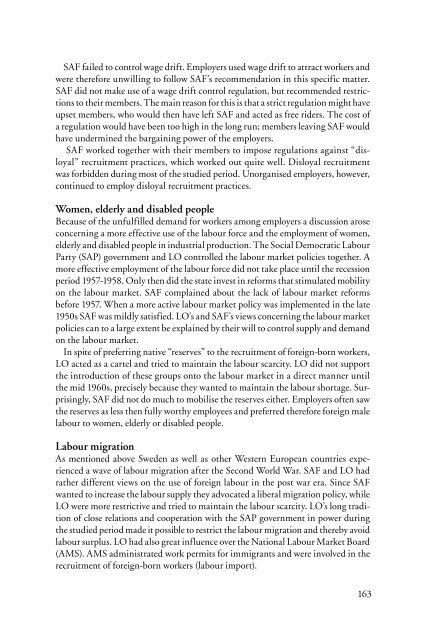gupea_2077_29098_3
gupea_2077_29098_3
gupea_2077_29098_3
You also want an ePaper? Increase the reach of your titles
YUMPU automatically turns print PDFs into web optimized ePapers that Google loves.
SAF failed to control wage drift. Employers used wage drift to attract workers and<br />
were therefore unwilling to follow SAF’s recommendation in this specific matter.<br />
SAF did not make use of a wage drift control regulation, but recommended restrictions<br />
to their members. The main reason for this is that a strict regulation might have<br />
upset members, who would then have left SAF and acted as free riders. The cost of<br />
a regulation would have been too high in the long run; members leaving SAF would<br />
have undermined the bargaining power of the employers.<br />
SAF worked together with their members to impose regulations against “disloyal”<br />
recruitment practices, which worked out quite well. Disloyal recruitment<br />
was forbidden during most of the studied period. Unorganised employers, however,<br />
continued to employ disloyal recruitment practices.<br />
Women, elderly and disabled people<br />
Because of the unfulfilled demand for workers among employers a discussion arose<br />
concerning a more effective use of the labour force and the employment of women,<br />
elderly and disabled people in industrial production. The Social Democratic Labour<br />
Party (SAP) government and LO controlled the labour market policies together. A<br />
more effective employment of the labour force did not take place until the recession<br />
period 1957-1958. Only then did the state invest in reforms that stimulated mobility<br />
on the labour market. SAF complained about the lack of labour market reforms<br />
before 1957. When a more active labour market policy was implemented in the late<br />
1950s SAF was mildly satisfied. LO’s and SAF’s views concerning the labour market<br />
policies can to a large extent be explained by their will to control supply and demand<br />
on the labour market.<br />
In spite of preferring native “reserves” to the recruitment of foreign-born workers,<br />
LO acted as a cartel and tried to maintain the labour scarcity. LO did not support<br />
the introduction of these groups onto the labour market in a direct manner until<br />
the mid 1960s, precisely because they wanted to maintain the labour shortage. Surprisingly,<br />
SAF did not do much to mobilise the reserves either. Employers often saw<br />
the reserves as less then fully worthy employees and preferred therefore foreign male<br />
labour to women, elderly or disabled people.<br />
Labour migration<br />
As mentioned above Sweden as well as other Western European countries experienced<br />
a wave of labour migration after the Second World War. SAF and LO had<br />
rather different views on the use of foreign labour in the post war era. Since SAF<br />
wanted to increase the labour supply they advocated a liberal migration policy, while<br />
LO were more restrictive and tried to maintain the labour scarcity. LO’s long tradition<br />
of close relations and cooperation with the SAP government in power during<br />
the studied period made it possible to restrict the labour migration and thereby avoid<br />
labour surplus. LO had also great influence over the National Labour Market Board<br />
(AMS). AMS administrated work permits for immigrants and were involved in the<br />
recruitment of foreign-born workers (labour import).<br />
163


